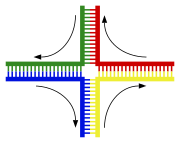Cruciform
This article's lead section may be too short to adequately summarize the key points. (September 2010) |
- For resurrection device/parasite at the Hyperion Cantos see Cruciform (Hyperion Cantos).
Cruciform means having the shape of a cross or Christian cross.
Cruciform architectural plan

Christian churches are commonly described as having a cruciform architecture. In Early Christian, Byzantine and other Eastern Orthodox forms of church architecture this is likely to mean a tetraconch plan, a Greek cross, with arms of equal length or, later, a cross-in-square plan.
In the Western churches, a cruciform architecture usually, though not exclusively, means a church built with the layout developed in Gothic architecture. This layout comprises the following:
- An east end, containing an altar and often with an elaborate, decorated window, through which light will shine in the early part of the day.
- A west end, which sometimes contains a baptismal font, being a large decorated bowl, in which water can be firstly, blessed (dedicated to the use and purposes of God) and then used for baptism.
- North and south transepts, being "arms" of the cross and often containing rooms for gathering, small side chapels, or in many cases other necessities such as an organ and toilets.
- The crossing, which in later designs often was under a tower or dome.
In churches that are not oriented with the altar at the geographical east end, it is usual to refer to the altar end as "liturgical east" and so forth.
Another example of ancient cruciform architecture[1] can be found in Herod's temple, the second Jewish temple.
Cruciform DNA
DNA can undergo transitions to form a cruciform shape, otherwise known as a Holliday junction. This structure is important for the critical biological processes of DNA recombination and repair that occur in the cell.
Cruciform joint
A cruciform joint is a specific joint in which 4 spaces are created by the welding of 3 plates of metal at right angles.
Cruciform manuscript
A cruciform manuscript was a form of Anglo-Saxon / Insular manuscript written with the words in a block shaped like a cross.
Cruciform melody
In music, a melody of four pitches where a straight line drawn between the outer pair bisects a straight line drawn between the inner pair, thus forming a cross (as in the red lines in the example to the right). In its simplest form, the cruciform melody is a changing tone, where the melody ascends or descends by step, skips below or above the first pitch, then returns to the first pitch by step. Often representative of the Christian cross, such melodies are cruciform in their retrogrades or inversions. Johann Sebastian Bach, whose last name may be represented in tones through a musical cryptogram known as the BACH motif that is a cruciform melody, employed the device extensively. The subject of the fugue in c-sharp minor from The Well-Tempered Clavier Book I is cruciform. See also: Cross motif.
Cruciform sword

The plain sword used by knights, distinctive due to the flat bar used as a guard. The overall shape of the sword when held point down is that of a cross.
It is believed this shape was encouraged by the church to remind Knights of their religion.[citation needed] It was however very popular due to the protection it offered to the hand and certain attacks that rely on the cross to trap the blade of the enemy. See Sword.
Cruciform tail

Some airplanes use a cruciform tail design, wherein the horizontal stabilizer is positioned mid-way up the vertical stabilizer, forming a cruciform shape when viewed from the front or rear. Some examples are the F-9 Cougar,the F-10 Skyknight and the Sud Aviation Caravelle.
The cruciform tail gives the benefit of clearing the aerodynamics of the tail away from the wake of the engine, while not requiring the same amount of strengthening of the vertical tail section in comparison with a T-tail design.
Cruciform web design
Cruciform web designs use a cross-shaped web page that expands to fill the width and height of the web browser window. There are a number of different approaches to implementing them.
See also
Sources
- ^ Jerome, Murphy-O'Connor (1998). The Holy Land: an Oxford archaeological guide from earliest times to 170. Oxford University Press, USA; 4 edition (June 25, 1998). p. 108. ISBN 0-19-288013-6.
- ^ a b Jackson, Timothy (1999). Symphony No. 6 (Pathétique), p.51. ISBN 0-521-64676-6.



